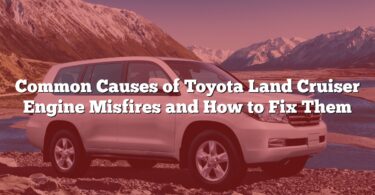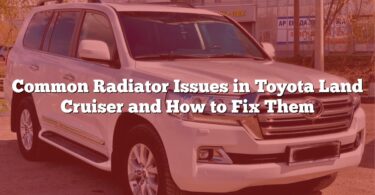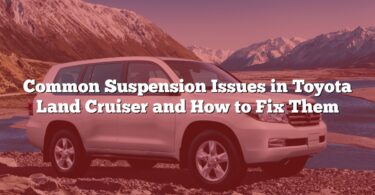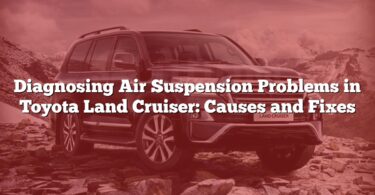Dashboard warning lights are your Toyota Land Cruiser’s way of communicating potential issues, ranging from minor alerts to serious problems requiring immediate attention. Understanding what triggers these warnings and how to address them is essential for maintaining your vehicle’s reliability and safety. This guide provides a detailed breakdown of common causes behind dashboard warning lights and practical solutions to keep your Land Cruiser running smoothly. Whether it’s a loose battery connection, a faulty sensor, or a complex system malfunction, this article will help you troubleshoot and resolve the issues efficiently.
Guide: 66 Dashboard Warning Light Issues in a Toyota Land Cruiser and Their Solutions
| N° | Problem/Cause | Possible Solution |
|---|---|---|
| 1 | Loose battery connections | Tighten or reconnect the battery terminals securely. |
| 2 | Faulty alternator | Replace or repair the alternator to restore charging functionality. |
| 3 | Worn-out or damaged wiring | Inspect and replace damaged wiring or connectors. |
| 4 | Malfunctioning sensors | Diagnose and replace the faulty sensor. |
| 5 | Low or contaminated engine oil | Refill or replace the engine oil and filter as needed. |
| 6 | Overheating engine | Check the coolant level, radiator, and thermostat; address any leaks or blockages. |
| 7 | Faulty brake system components | Inspect and repair or replace the defective brake system parts. |
| 8 | Low brake fluid levels | Refill the brake fluid and inspect for leaks. |
| 9 | Malfunctioning ABS module | Replace the ABS module or repair the electrical connection. |
| 10 | Airbag system failure | Diagnose and repair the airbag system with a certified technician. |
| 11 | Faulty or disconnected airbags | Inspect airbag connections and replace damaged components. |
| 12 | Low tire pressure | Inflate tires to the recommended pressure. |
| 13 | Faulty TPMS | Diagnose and replace the TPMS sensor. |
| 14 | Loose fuel cap | Securely tighten or replace the fuel cap. |
| 15 | Evaporative emission system leaks | Inspect the EVAP system for leaks and repair or replace components. |
| 16 | Faulty fuel pump | Replace the malfunctioning fuel pump. |
| 17 | Clogged fuel injectors | Clean or replace clogged fuel injectors. |
| 18 | Dirty or clogged air filter | Replace the air filter. |
| 19 | Malfunctioning catalytic converter | Inspect and replace the catalytic converter. |
| 20 | Faulty MAF sensor | Clean or replace the mass airflow sensor. |
| 21 | Faulty throttle position sensor | Replace the defective throttle position sensor. |
| 22 | Engine misfire | Diagnose and replace faulty ignition components. |
| 23 | Spark plug or ignition coil issues | Replace the spark plugs or ignition coil. |
| 24 | Malfunctioning EGR valve | Clean or replace the EGR valve. |
| 25 | Transmission fluid issues | Check fluid level and condition; replace if necessary. |
| 26 | Faulty transmission components | Diagnose and repair or replace damaged transmission components. |
| 27 | Battery voltage irregularities | Test and replace the battery or voltage regulator if needed. |
| 28 | Electrical system failures | Inspect and repair the electrical circuits or fuses. |
| 29 | Corroded or damaged fuses | Replace the corroded or damaged fuses. |
| 30 | Malfunctioning instrument cluster | Diagnose and repair or replace the instrument cluster. |
| 31 | Faulty ECU | Reprogram or replace the ECU. |
| 32 | Faulty BCM | Diagnose and replace the body control module. |
| 33 | Sensor calibration issues | Recalibrate the sensor or replace if faulty. |
| 34 | Water intrusion into electrical components | Dry and inspect the affected components; repair damaged parts. |
| 35 | Malfunctioning seatbelt sensors | Inspect and replace defective sensors. |
| 36 | Low coolant levels | Refill coolant and check for leaks. |
| 37 | Faulty thermostat | Replace the thermostat. |
| 38 | Glow plug issues (diesel models) | Replace malfunctioning glow plugs. |
| 39 | Exhaust system leaks | Inspect and repair leaks in the exhaust system. |
| 40 | Software glitches or outdated firmware | Update the ECU software. |
| 41 | Rodent damage to wiring | Replace chewed or damaged wiring; install deterrents. |
| 42 | Improper installation of accessories | Reinstall or correct improperly installed accessories. |
| 43 | Incorrect vehicle maintenance | Follow the manufacturer’s recommended maintenance schedule. |
| 44 | Driving with incompatible parts | Replace with compatible components. |
| 45 | Aging vehicle components | Inspect and replace worn-out parts. |
| 46 | Hybrid system requiring service | Consult a hybrid system specialist for diagnostics. |
| 47 | Faulty power steering system | Repair or replace the power steering system components. |
| 48 | Malfunction in anti-theft system | Reset or repair the anti-theft system. |
| 49 | Transmission oil overheating | Allow the transmission to cool; replace old transmission oil. |
| 50 | Oil temperature overheating | Cool the engine and inspect oil levels or conditions. |
| 51 | Brake pad wear | Replace worn brake pads. |
| 52 | Charging system issues | Test and replace the charging system components as needed. |
| 53 | Low washer fluid | Refill the washer fluid. |
| 54 | Lane departure warnings | Clean sensors or recalibrate the lane departure system. |
| 55 | Forward collision system deactivated | Reset or repair the forward collision detection system. |
| 56 | Malfunctioning adaptive cruise control | Recalibrate or repair adaptive cruise control components. |
| 57 | Engine air filter blockage | Replace the air filter. |
| 58 | Water in fuel (diesel engines) | Drain water from the fuel system and replace the filter. |
| 59 | Glow plug failure | Replace faulty glow plugs. |
| 60 | Brake override malfunctions | Reset or repair the brake override system. |
| 61 | AdBlue depletion | Refill the AdBlue tank. |
| 62 | Headlight or taillight malfunctions | Replace the malfunctioning light bulb. |
| 63 | Immobilizer system errors | Reprogram or repair the immobilizer system. |
| 64 | Air suspension issues | Diagnose and repair the air suspension system. |
| 65 | Automatic transmission faults | Diagnose and repair the automatic transmission system. |
| 66 | Hood or trunk not properly closed | Ensure the hood or trunk is securely closed. |
Detailed Guide: Dashboard Warning Light Issues in a Toyota Land Cruiser and Their Solutions
1. Loose Battery Connections
Reasons:
- The battery terminals might be loose due to vibrations during driving.
- Corrosion on the battery terminals could weaken the connection.
Solution:
- Step 1: Inspect the battery terminals for looseness or corrosion.
- Step 2: Clean the terminals using a wire brush and a mixture of baking soda and water.
- Step 3: Tighten the battery connections securely, ensuring a snug fit without over-tightening.
2. Faulty Alternator
Reason:
- The alternator may fail due to wear and tear or electrical issues, causing the battery to not charge properly.
Solution:
- Have the alternator tested using a voltmeter or at a service center.
- Replace or repair the alternator if the output voltage is not within the manufacturer’s specifications.
3. Worn-Out or Damaged Wiring
Reason:
- Over time, wiring may degrade or become damaged due to friction, heat, or rodent activity.
Solution:
- Inspect the wiring for visible damage or exposed wires.
- Replace any frayed or damaged wiring with new, insulated wires.
4. Malfunctioning Sensors
Reason:
- Sensors such as the oxygen sensor or temperature sensor might fail due to age or contamination.
Solution:
- Use an OBD-II scanner to identify the faulty sensor.
- Replace the sensor and ensure it is properly calibrated for accurate readings.
5. Low or Contaminated Engine Oil
Reasons:
- Engine oil levels may drop due to leaks.
- Contaminated oil could result from irregular oil changes.
Solution:
- Check the engine oil level using the dipstick.
- If low, refill with the recommended oil type.
- Replace the oil and filter if contaminated.
6. Overheating Engine
Reasons:
- Low coolant levels.
- Malfunctioning radiator or water pump.
Solution:
- Step 1: Allow the engine to cool before opening the radiator cap.
- Step 2: Refill the coolant reservoir to the recommended level.
- Step 3: Inspect the radiator and water pump for leaks and repair or replace them if necessary.
7. Faulty Brake System Components
Reasons:
- Worn-out brake pads.
- Malfunctioning calipers or rotors.
Solution:
- Inspect the brake system for wear or damage.
- Replace worn-out components such as brake pads, calipers, or rotors as needed.
8. Low Brake Fluid Levels
Reasons:
- Brake fluid may evaporate or leak over time.
Solution:
- Refill the brake fluid reservoir with the recommended type.
- Inspect the system for leaks and repair any damaged components.
9. Malfunctioning ABS Module
Reason:
- Electrical issues or wear could cause the ABS module to malfunction.
Solution:
- Diagnose the ABS system using an OBD-II scanner.
- Replace or repair the ABS module as needed.
10. Airbag System Failure
Reason:
- Faulty sensors or disconnected wiring in the airbag system.
Solution:
- Have the airbag system inspected by a certified technician.
- Replace damaged sensors or reconnect the wiring.
11. Faulty or Disconnected Airbags
Reasons:
- Airbags may be disconnected during repairs.
- Damage to the airbag system wiring.
Solution:
- Reconnect the airbag system wiring securely.
- Replace any damaged components and ensure the system is functional.
12. Low Tire Pressure
Reason:
- Loss of air due to punctures, temperature changes, or normal usage.
Solution:
- Check the tire pressure using a gauge.
- Inflate the tires to the recommended PSI as listed on the driver-side door.
13. Faulty TPMS
Reason:
- A malfunctioning tire pressure monitoring system sensor.
Solution:
- Replace the faulty TPMS sensor with a compatible replacement.
14. Loose Fuel Cap
Reason:
- The fuel cap might not be securely tightened after refueling.
Solution:
- Tighten the fuel cap until it clicks.
- If the problem persists, replace the cap with a new one.
15. Evaporative Emission System Leaks
Reason:
- Cracks or leaks in the EVAP system hoses or components.
Solution:
- Inspect the EVAP system for leaks using a smoke machine or diagnostic tools.
- Replace damaged hoses or components as required.
16. Faulty Fuel Pump
Reason:
- Wear and tear or contamination in the fuel system can cause the pump to fail.
Solution:
- Test the fuel pump’s pressure output.
- Replace the pump if it fails to meet specifications.
17. Clogged Fuel Injectors
Reason:
- Deposits build up in the fuel injectors over time, restricting fuel flow.
Solution:
- Use a fuel injector cleaning kit or professional cleaning service.
- Replace injectors if cleaning does not resolve the issue.
18. Dirty or Clogged Air Filter
Reason:
- Dust and debris accumulate in the air filter, restricting airflow.
Solution:
- Inspect and replace the air filter with a new one to restore airflow.
19. Malfunctioning Catalytic Converter
Reason:
- Blockages or overheating in the converter due to poor engine performance.
Solution:
- Diagnose the exhaust system for issues.
- Replace the catalytic converter if necessary.
20. Faulty Mass Airflow (MAF) Sensor
Reason:
- Contamination or wear in the MAF sensor affects air intake readings.
Solution:
- Clean the MAF sensor using a specialized cleaner.
- Replace the sensor if cleaning does not resolve the issue.
21. Faulty Throttle Position Sensor
Reason:
- The throttle position sensor (TPS) may wear out, leading to inaccurate throttle readings.
Solution:
- Use a diagnostic scanner to confirm TPS malfunction.
- Replace the faulty TPS with a new one and recalibrate it if required.
22. Engine Misfire
Reasons:
- Faulty spark plugs or ignition coils.
- Insufficient fuel delivery or air intake.
Solution:
- Inspect the spark plugs and ignition coils; replace any defective components.
- Check fuel injectors and air filters for clogs, and clean or replace them as needed.
23. Spark Plug or Ignition Coil Issues
Reason:
- Worn-out spark plugs or damaged ignition coils may disrupt engine performance.
Solution:
- Remove and inspect the spark plugs; replace them if worn or fouled.
- Test the ignition coils for proper voltage output and replace faulty ones.
24. Malfunctioning EGR Valve
Reason:
- A clogged or stuck Exhaust Gas Recirculation (EGR) valve can disrupt emissions control.
Solution:
- Clean the EGR valve with a carburetor cleaner to remove carbon buildup.
- Replace the EGR valve if cleaning does not resolve the issue.
25. Transmission Fluid Issues
Reasons:
- Low or contaminated transmission fluid may impair gear shifting.
Solution:
- Check the transmission fluid level and color using the dipstick.
- Refill or replace the fluid and filter according to the manufacturer’s guidelines.
26. Faulty Transmission Components
Reason:
- Internal transmission parts, like solenoids or gears, may wear out or fail.
Solution:
- Conduct a thorough diagnostic of the transmission system.
- Repair or replace damaged components as needed, such as solenoids or clutch assemblies.
27. Battery Voltage Irregularities
Reasons:
- A weak or failing battery.
- Problems with the voltage regulator.
Solution:
- Test the battery voltage with a multimeter; replace the battery if it is below 12.4 volts.
- Inspect the voltage regulator and alternator output; repair or replace faulty components.
28. Electrical System Failures
Reason:
- Faulty wiring or blown fuses could disrupt electrical systems.
Solution:
- Inspect the vehicle’s electrical circuits and replace blown fuses.
- Repair or replace damaged wiring and connectors.
29. Corroded or Damaged Fuses
Reason:
- Moisture or age can cause fuses to corrode or fail.
Solution:
- Remove and inspect the fuses; clean corrosion with a contact cleaner.
- Replace any damaged or faulty fuses with ones of the correct amperage.
30. Malfunctioning Instrument Cluster
Reasons:
- Faulty wiring or damaged internal components.
Solution:
- Check for loose connections behind the instrument cluster.
- Repair or replace the cluster if necessary.
31. Faulty ECU (Engine Control Unit)
Reason:
- A malfunction in the ECU could result from software glitches or hardware failure.
Solution:
- Reprogram the ECU with updated software at an authorized service center.
- Replace the ECU if reprogramming does not resolve the issue.
32. Faulty BCM (Body Control Module)
Reason:
- The BCM may fail due to electrical issues or internal damage.
Solution:
- Diagnose the BCM using a scanner to identify faults.
- Replace the BCM if it cannot be repaired.
33. Sensor Calibration Issues
Reason:
- Sensors might require recalibration after maintenance or replacement.
Solution:
- Use diagnostic tools to recalibrate affected sensors to factory settings.
34. Water Intrusion into Electrical Components
Reason:
- Water can seep into electrical systems due to leaks or heavy rain.
Solution:
- Locate the source of the leak and seal it.
- Dry affected components thoroughly and replace any damaged ones.
35. Malfunctioning Seatbelt Sensors
Reason:
- Faulty sensors may fail to detect whether seatbelts are fastened.
Solution:
- Inspect and replace the faulty seatbelt sensors to restore functionality.
36. Low Coolant Levels
Reason:
- Coolant may evaporate or leak over time.
Solution:
- Refill the coolant reservoir with the manufacturer-recommended coolant.
- Inspect for leaks in hoses or the radiator and repair as needed.
37. Faulty Thermostat
Reason:
- A stuck or malfunctioning thermostat can cause overheating or poor heat circulation.
Solution:
- Replace the thermostat and test for proper operation.
38. Glow Plug Issues (Diesel Models)
Reason:
- Glow plugs may wear out, especially in cold climates.
Solution:
- Test each glow plug for resistance using a multimeter.
- Replace faulty glow plugs to ensure proper engine start-up.
39. Exhaust System Leaks
Reason:
- Cracks or corrosion in the exhaust system components.
Solution:
- Inspect the exhaust pipes, manifold, and muffler for leaks.
- Repair or replace damaged components.
40. Software Glitches or Outdated Firmware
Reason:
- ECU or system software may become outdated or buggy.
Solution:
- Update the vehicle’s software at a certified dealership.
41. Rodent Damage to Wiring
Reason:
- Rodents may chew through wires, causing electrical issues.
Solution:
- Inspect the wiring for damage and replace affected sections.
- Use rodent deterrents like sprays or covers.
42. Improper Installation of Accessories
Reason:
- Aftermarket accessories may not be installed correctly, causing interference.
Solution:
- Reinstall or adjust the accessories according to the manufacturer’s instructions.
43. Incorrect Vehicle Maintenance
Reason:
- Skipping scheduled maintenance or using incorrect parts.
Solution:
- Follow the maintenance schedule in the owner’s manual.
- Use recommended parts and fluids.
44. Driving with Incompatible Parts
Reason:
- Using incompatible parts can cause system failures or errors.
Solution:
- Replace incompatible parts with OEM or approved alternatives.
45. Aging Vehicle Components
Reason:
- Wear and tear over time affect vehicle performance.
Solution:
- Regularly inspect and replace aging components as needed.
46. Hybrid System Requiring Service
Reason:
- The hybrid system may signal an alert due to worn-out components or software issues.
Solution:
- Take the vehicle to a certified hybrid specialist for a diagnostic check.
- Replace defective components, such as the hybrid battery or inverter, if necessary.
- Update the hybrid system software to ensure optimal performance.
47. Faulty Power Steering System
Reasons:
- Low power steering fluid levels.
- Malfunctioning electric power steering (EPS) motor or module.
Solution:
- For hydraulic systems, check and refill the power steering fluid to the recommended level.
- Inspect the EPS motor and module for errors using a diagnostic scanner and replace faulty components if required.
48. Malfunction in Anti-Theft System
Reason:
- A glitch in the anti-theft system can disable the vehicle or trigger warning lights.
Solution:
- Attempt to reset the system by locking and unlocking the car with the key fob.
- If the issue persists, consult a certified mechanic to inspect the immobilizer or alarm system.
49. Transmission Oil Overheating
Reasons:
- Prolonged high-speed driving or towing.
- Low or aged transmission oil.
Solution:
- Allow the transmission to cool by parking the vehicle in a safe location.
- Check the transmission fluid level and condition; refill or replace as necessary.
- Install an auxiliary transmission cooler if overheating occurs frequently during towing.
50. Oil Temperature Overheating
Reason:
- Vigorous driving or insufficient engine oil may cause the oil to overheat.
Solution:
- Let the engine cool down before checking the oil level.
- Top off the oil if it is low, or replace it with the manufacturer-recommended oil if degraded.
51. Brake Pad Wear
Reason:
- Brake pads naturally wear down with use, triggering a warning light.
Solution:
- Inspect the brake pads for thickness.
- Replace pads if they are below the minimum thickness (typically 3mm) to ensure safety.
52. Charging System Issues
Reasons:
- A failing alternator.
- Loose or corroded battery connections.
Solution:
- Test the alternator output with a voltmeter.
- Tighten or clean the battery connections and replace damaged cables.
53. Low Washer Fluid
Reason:
- The washer fluid reservoir is empty or nearly empty.
Solution:
- Refill the washer fluid reservoir with a suitable windshield washer solution.
54. Lane Departure Warnings
Reasons:
- Dirty or obstructed sensors or cameras.
- Calibration issues.
Solution:
- Clean the camera lens and sensors to remove dirt or debris.
- Recalibrate the system using the vehicle’s onboard settings or consult a technician.
55. Forward Collision System Deactivated
Reasons:
- The system may have been manually turned off.
- Sensor or camera malfunction.
Solution:
- Check the system settings and reactivate forward collision detection.
- Inspect and clean the sensors; if the warning persists, consult a professional for repairs.
56. Malfunctioning Adaptive Cruise Control
Reasons:
- Radar or camera malfunction.
- Electrical issues in the cruise control system.
Solution:
- Clean the radar sensor and camera lens.
- Test the cruise control system for electrical faults using diagnostic tools and replace defective parts.
57. Engine Air Filter Blockage
Reason:
- Dirt and debris block the engine air filter, restricting airflow.
Solution:
- Remove the air filter and inspect it for clogs.
- Replace the air filter if it appears dirty or damaged.
58. Water in Fuel (Diesel Engines)
Reason:
- Water contamination in diesel fuel.
Solution:
- Drain the water from the fuel filter or fuel-water separator.
- Replace the fuel filter and use a fuel additive to prevent future contamination.
59. Glow Plug Failure
Reasons:
- Worn-out glow plugs.
- Electrical issues in the glow plug circuit.
Solution:
- Test each glow plug using a multimeter to measure resistance.
- Replace defective glow plugs and inspect the wiring for continuity.
60. Brake Override Malfunctions
Reason:
- Simultaneous engagement of the accelerator and brake pedals.
- Faulty sensors in the brake override system.
Solution:
- Avoid pressing both pedals simultaneously.
- Have the system inspected by a mechanic to identify and replace faulty sensors.
61. AdBlue Depletion
Reason:
- The AdBlue reservoir is empty or low, triggering a warning light.
Solution:
- Refill the AdBlue tank with the appropriate fluid as specified in the owner’s manual.
- Ensure the system is reset after refilling.
62. Headlight or Taillight Malfunctions
Reasons:
- Burnt-out bulbs.
- Electrical wiring issues.
Solution:
- Replace the malfunctioning bulb with a compatible one.
- Inspect the wiring for continuity and repair any loose connections.
63. Immobilizer System Errors
Reasons:
- Faulty key fob or immobilizer unit.
- Communication issues between the key and ECU.
Solution:
- Replace the key fob battery if the signal is weak.
- Reprogram or repair the immobilizer system as needed.
64. Air Suspension Issues
Reasons:
- Faulty air compressor or leaks in the suspension system.
- Malfunctioning height sensors.
Solution:
- Inspect the air suspension system for leaks or damaged components.
- Repair or replace the air compressor and recalibrate the height sensors.
65. Automatic Transmission Faults
Reasons:
- Solenoid or clutch issues.
- Insufficient or degraded transmission fluid.
Solution:
- Diagnose the transmission system using an OBD-II scanner.
- Repair or replace faulty solenoids or clutches and replace the fluid if necessary.
66. Hood or Trunk Not Properly Closed
Reason:
- The hood or trunk latch is not fully engaged.
Solution:
- Open and firmly close the hood or trunk to ensure it is securely latched.
- If the warning persists, inspect the latch sensor and replace it if faulty.
Preventing Future Issues
To minimize dashboard warning light problems and ensure your Toyota Land Cruiser runs smoothly, follow these preventive steps:
- Regular Maintenance:
- Schedule routine maintenance as outlined in your owner’s manual.
- Ensure timely oil changes, fluid top-offs, and inspections.
- Inspect the Battery and Connections:
- Check battery terminals for corrosion and secure connections regularly.
- Replace the battery every 3-5 years or as needed.
- Keep Sensors and Cameras Clean:
- Regularly clean cameras and sensors for systems like lane departure and adaptive cruise control.
- Use a soft cloth to remove dirt or debris.
- Monitor Fluid Levels:
- Check engine oil, transmission fluid, coolant, brake fluid, and washer fluid monthly.
- Refill and replace fluids with manufacturer-recommended products.
- Maintain Tire Pressure:
- Inspect tire pressure weekly and keep it at the recommended PSI.
- Rotate tires and check for damage or uneven wear regularly.
- Inspect Belts and Hoses:
- Examine engine belts and hoses for cracks or wear during oil changes.
- Replace worn or damaged components immediately.
- Use Quality Fuel and Fluids:
- Use high-quality fuel to prevent injector clogging and water contamination.
- Ensure all fluids meet Toyota’s specifications.
- Update Software:
- Visit an authorized service center periodically to check for and install ECU or system software updates.
- Protect Against Rodents:
- Park in a secure location and use rodent deterrents if necessary.
- Inspect wiring and components for signs of damage.
- Address Minor Issues Promptly:
- Pay attention to small warning signs, like unusual noises or vibrations, before they escalate into major problems.
- Use an OBD-II scanner to diagnose minor errors and address them promptly.
By following these steps, you can significantly reduce the likelihood of dashboard warning light issues and keep your vehicle in optimal condition.







